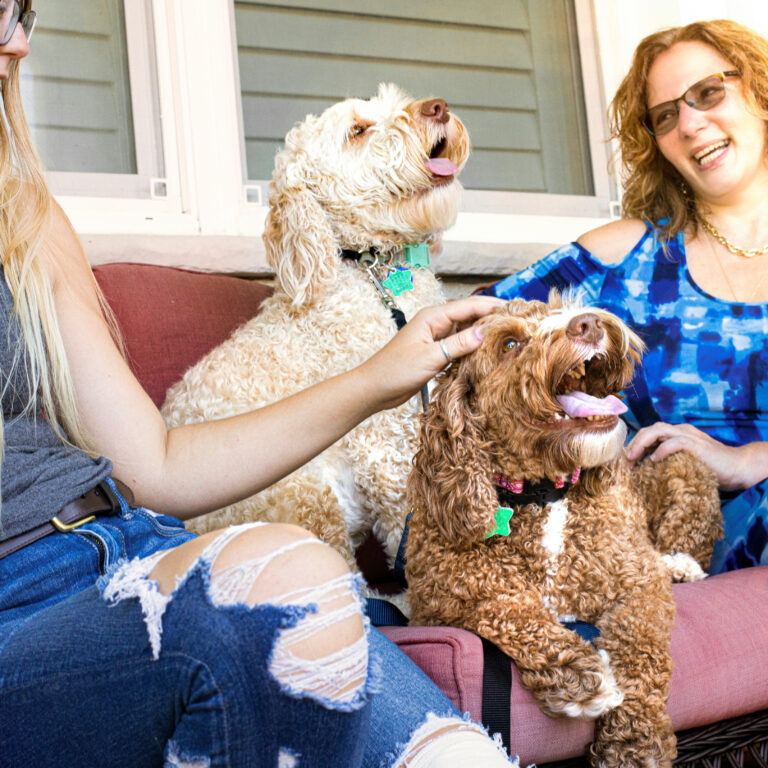Mastering Dog Tail Language: Decode Joy and Warning Signals
Mastering Dog Tail Language: Decode Joy and Warning Signals
In this article, you will learn how to interpret your dogs tail movements to understand their emotions and intentions, enhancing your bond and communication with your pet.

Introduction to Dog Tail Communication
Dogs possess a nuanced and rich language of tail movements, which they use to convey a broad spectrum of emotions and intentions. This intricate system of non-verbal communication is not just a fascinating aspect of canine behavior, but a crucial element for owners to understand and interpret correctly. By mastering the art of reading these tail signals, owners can unlock a deeper level of empathy and connection with their dogs, fostering a relationship built on mutual understanding and respect.
Tail movements and positions can serve as a window into a dog’s emotional state, ranging from wagging and twirling to indicate joy and excitement, to stiffening or tucking under as signs of anxiety, fear, or aggression. Recognizing these cues is essential for responding appropriately to a dog’s needs and emotions, preventing misunderstandings, and ensuring a happy, healthy coexistence.
Dayton Off Leash K9 Dog Training emphasizes the importance of understanding these signals, incorporating dog tail language education into their training programs. By equipping owners with the knowledge to interpret their dogs’ tail movements correctly, they aim to enhance the bond between dogs and their owners, making communication clearer and more effective. For more insights into understanding and interpreting your dog’s tail language, explore the training programs offered by Dayton Off Leash K9 Dog Training at https://daytonohiooffleashdogtrainers.com/.
 Understanding the Basics of Dog Tail Language
Understanding the Basics of Dog Tail Language
Dog tail language is an intricate system of non-verbal communication that provides invaluable insights into our canine companions’ emotional states and intentions. The position of a dog’s tail can range dramatically, from high and alert to low and tucked, each conveying a distinct message. A tail held high often suggests confidence or alertness, serving as a sign that the dog is engaged with its surroundings. Conversely, a tail tucked between the legs is a universal signal of fear, submission, or anxiety, indicating that the dog feels threatened or uncomfortable. This diverse range of tail positions forms the basis of canine body language, allowing dogs to express a wide array of emotions without uttering a single sound.
The nuances of tail wagging further enrich the complexity of dog tail language. The speed, direction, and pattern of a wag can reveal much about a dog’s mood and intentions. For instance, a slow, sweeping wag typically denotes contentment and a relaxed state, suggesting the dog is comfortable and happy with the current situation. On the other hand, a rapid wag, especially when combined with a stiff body posture, might indicate excitement or even potential agitation.
Interestingly, research suggests that the direction of tail wagging can also hold meaning, with a preference for wagging to the right being associated with positive emotions, while wagging to the left may denote negative feelings. Understanding these subtle differences in tail movement can greatly enhance an owner’s ability to interpret their dog’s needs and feelings, leading to a deeper and more empathetic bond.
Deciphering Joy and Happiness in Tail Movements
Understanding the subtleties of a dog’s tail wagging can significantly enhance the bond between pet and owner. When a dog’s tail is held high, wagging rapidly, it’s a vivid expression of joy and excitement. This behavior can be observed in various situations, such as when you come home after an absence, and your dog greets you with not just a high, vigorously wagging tail but potentially also with a full-body wiggle, spinning in circles, or emitting playful barks. Such displays of happiness are not merely signs of your dog’s pleasure at seeing you but also an invitation for interaction and play, demonstrating their comfort and security in your presence.
Moreover, the way a dog wags its tail can convey different levels of happiness. For instance, a slight wag with a relaxed body may indicate mild contentment, while a full, enthusiastic wag, where the tail seems to be wagging the dog, suggests extreme elation. Recognizing these variations helps in understanding the depth of a dog’s emotions at any given time.
For those looking to deepen their understanding of their canine companions, Dayton Off Leash K9 Dog Training offers programs that cover the nuances of dog body language, including tail movements. By learning to interpret these signals accurately, owners can ensure they are responding appropriately to their dog’s needs and emotions, fostering a happier, more harmonious relationship. For more information on how to enhance communication with your pet through tail language, visit Dayton Off Leash K9 Dog Training.
Recognizing Warning Signals and Stress
Deciphering the subtleties of a dog’s tail position is pivotal in identifying their feelings of stress or discomfort. A tail that is tucked between the legs is a classic sign of fear or anxiety in dogs. This posture, often accompanied by a lowered head and flattened ears, suggests a desire to appear smaller and less threatening, signaling a need for comfort or reassurance from their owners.
In more nuanced scenarios, a tail that is held stiffly, especially if it’s higher than the natural resting position, can denote a heightened state of alertness or arousal. This could be a dog’s way of showing they are on guard or feeling defensive, possibly in response to an unfamiliar stimulus or perceived threat. Understanding these warning signals is not only essential for mitigating potentially harmful situations but also for providing the appropriate support and space your canine companion might require in moments of distress.
Moreover, the intensity and pattern of tail wagging can further elucidate a dog’s internal state. While a relaxed wagging might indicate a calm and happy dog, a rapid wag with a stiff tail often points to overstimulation or agitation. This is particularly important in social settings where dogs interact with unfamiliar humans or other animals. Misinterpreting these signals as friendliness can lead to uncomfortable or even dangerous encounters.
Recognizing and responding appropriately to these signs of stress and warning can greatly enhance the safety and well-being of your dog, reinforcing a trusting and understanding relationship between pet and owner. For those seeking to deepen their bond with their furry friends, Dayton Off Leash K9 Dog Training offers comprehensive programs that cover all aspects of dog communication, including tail signaling. Explore their training options at https://daytonohiooffleashdogtrainers.com/ to ensure you and your pet enjoy a harmonious and connected life together.
Tail Positions and Their Meanings
The position of a dog’s tail can serve as a powerful indicator of their emotional state and intentions, acting almost like a language of its own. For instance, when a dog holds its tail low or tucks it between its legs, it’s often a sign of submission, insecurity, or fear.
This posture can be observed in situations where a dog is faced with an unfamiliar or intimidating scenario, signaling their discomfort or desire to avoid confrontation. On the other hand, a tail that’s held high, especially if it’s stiff and quivering, can suggest that a dog is in a state of high alert. This could mean the dog is assessing a potential threat or preparing to assert itself. Such nuances in tail position offer invaluable clues to understanding a dog’s mindset and can help owners respond appropriately to their pets’ needs.
Moreover, tail positions vary greatly and can convey a wide array of emotions beyond just fear or alertness. A relaxed tail, for instance, held at a mid-range height, indicates a dog that is comfortable and content in its environment. In contrast, rapid tail wagging combined with a high tail position might not only show excitement but could also indicate a level of overstimulation or anxiety, especially if accompanied by other signs like barking or pacing.
Recognizing these subtle differences in tail language is crucial for dog owners to accurately gauge their pet’s mood and well-being. By paying attention to these signals, owners can enhance their communication with their furry friends, leading to a stronger and more empathetic bond. Dayton Off Leash K9 Dog Training emphasizes the importance of understanding these non-verbal cues in their training programs, providing owners with the tools they need to foster a healthy relationship with their pets. For more insights into dog behavior and tail language, visit Dayton Off Leash K9 Dog Training.
 Interpreting Tail Wagging: Context Matters
Interpreting Tail Wagging: Context Matters
Deciphering the nuanced language of tail wagging requires a deep understanding of context and awareness of the dog’s overall body language. For example, a slow, languid wag with the tail positioned at half-mast often signals a dog’s uncertainty or mild concern, possibly serving as a tentative form of greeting when encountering something or someone unfamiliar.
This contrasts sharply with the rapid, enthusiastic tail wagging seen when a dog greets a well-known and beloved companion, showcasing joy and eagerness. The direction of tail wagging also holds significant meaning; research indicates that dogs may wag more towards the left side of their body when experiencing negative emotions, a subtle cue that can be easily overlooked without careful observation.
Understanding these signals in conjunction with the broader context—such as the dog’s environment, the presence of unfamiliar animals or people, and other non-verbal cues like posture and ear position—provides a comprehensive insight into a dog’s emotional state. For instance, a dog that wags its tail while maintaining a relaxed posture and soft eyes is likely conveying happiness and contentment.
Conversely, tail wagging paired with stiff body language or bared teeth might indicate a conflicted state of mind, where excitement or interest is tempered by anxiety or aggression. Recognizing and interpreting these complex signals are crucial for nurturing a harmonious relationship between dogs and their owners, a principle that underpins the training programs offered by Dayton Off Leash K9 Dog Training.
Their expertise in canine communication can help demystify your dog’s tail language, enabling a deeper bond and understanding. Explore their offerings at Dayton Off Leash K9 Dog Training to enhance your connection with your pet through the art of tail communication.
Building a Stronger Bond Through Tail Language
Grasping the nuances of your dog’s tail language can profoundly impact the connection you share with your furry companion. When you accurately interpret and react to your dog’s tail movements, it not only communicates your attentiveness to their emotional state but also strengthens your bond.
This level of understanding signals to your dog that their feelings are recognized and valued, laying the foundation for a relationship built on mutual respect and trust. Tail language, with its subtle cues, offers a window into your dog’s emotions, enabling you to respond more effectively to their needs and comfort them when they’re stressed or anxious.
The significance of tail language in enhancing the human-dog relationship is a core component of the training programs at Dayton Off Leash K9 Dog Training. By educating dog owners on how to decipher their dog’s tail movements, these programs aim to bridge the communication gap between humans and their canine friends. For instance, learning that a wagging tail doesn’t always signify happiness but can also indicate nervousness or agitation, can prevent misunderstandings and foster a safer, more harmonious interaction.
With Dayton Off Leash K9 Dog Training’s guidance, owners are equipped with the knowledge to not only understand but also anticipate their dog’s needs, reinforcing a bond that is both rewarding and fulfilling. Enhance your relationship with your dog by exploring the comprehensive training programs available at Dayton Off Leash K9 Dog Training, where mastering the art of tail communication opens the door to a deeper connection with your pet.

Common Misconceptions About Dog Tail Language
One of the most widespread misunderstandings about canine communication is the assumption that a wagging tail is an exclusive sign of a friendly and happy dog, eager for interaction. This oversimplification can sometimes lead to misinterpretation of a dog’s true feelings and intentions.
Tail wagging, in reality, is a nuanced form of expression that can indicate a spectrum of emotions ranging from joy and excitement to anxiety, insecurity, or even aggression. It’s crucial to observe the pattern, speed, and direction of the wag, along with the dog’s overall body language and the context in which the behavior occurs, to accurately gauge what the dog is communicating. For instance, a slow wag with the tail positioned low might signal uncertainty or mild concern, while an intense wag with a stiff tail could indicate a state of alertness or agitation.
Moreover, another common misconception is that certain breeds of dogs, due to their tail characteristics (such as those with naturally short tails or breeds that commonly undergo tail docking), are less expressive or communicative through their tail movements. This belief underestimates the adaptability and range of non-verbal cues dogs use to communicate, including ear positioning, body posture, and vocalizations.
Understanding the full spectrum of these signals is essential for interpreting a dog’s mood and intentions accurately. Dayton Off Leash K9 Dog Training emphasizes the importance of comprehensive body language education in their training programs. By fostering a deeper understanding of canine communication, they help build stronger, more empathetic relationships between dogs and their owners. Discover how their training programs can enhance your ability to read and respond to your dog’s tail language and more by visiting Dayton Off Leash K9 Dog Training.
How Dayton Off Leash K9 Dog Training Can Help
Dayton Off Leash K9 Dog Training specializes in an array of programs that go beyond basic obedience to include a deep dive into canine body language, with a significant emphasis on tail communication. This focus is pivotal, as understanding the subtle nuances of a dog’s tail can reveal much about their feelings, intentions, and overall well-being.
Tail language, a critical component of canine communication, is often overlooked, yet it provides key insights that can prevent misunderstandings and strengthen the relationship between a dog and its owner. By integrating this knowledge into their training approach, Dayton Off Leash K9 ensures that owners are well-equipped to interpret their pets’ signals accurately, leading to more harmonious and responsive interactions.
Moreover, their training programs are tailored to address the unique needs of each dog and owner, fostering an environment of mutual respect and understanding. Through hands-on lessons and practical exercises, owners learn to read and respond to their dog’s tail movements, whether it’s the happy wag of excitement or the tense, slow wag that signals discomfort. This nuanced understanding of tail language empowers owners to meet their dogs’ needs more effectively, enhancing their bond and ensuring a happier, more contented pet.
The expert trainers at Dayton Off Leash K9 Dog Training are committed to helping owners build this level of communication, encouraging a deeper connection that transcends basic commands. For those looking to achieve a profound bond with their canine companions, exploring the programs offered by Dayton Off Leash K9 Dog Training at https://daytonohiooffleashdogtrainers.com/ is an excellent first step toward understanding and mutual respect.

Conclusion: Enhancing Canine Communication Through Tail Signals
Understanding your dog’s tail language is more than just recognizing when they’re happy or scared; it’s about developing a deeper bond that transcends verbal communication. This skill not only enhances the relationship between you and your furry companion but also ensures their well-being by allowing you to respond to their needs and emotions more effectively.
The subtleties in tail movements—from the excited wagging indicating joy to the low, slow sweeps signaling apprehension—reveal a spectrum of emotions and intentions that, when understood, can significantly improve the way you interact with your dog. It’s a journey towards mutual respect and understanding, where each tail wag has the potential to tell a story.
Dayton Off Leash K9 Dog Training offers specialized programs that focus on understanding canine behavior, including the nuances of tail language. Their expert trainers guide dog owners through the process of decoding these signals, fostering a relationship built on clear communication and mutual trust.
By investing in such training, you’re not just teaching your dog commands; you’re learning to speak their language, which is pivotal in preventing misunderstandings and strengthening the bond you share. As you master the art of interpreting your dog’s tail movements, you’ll find that this non-verbal dialogue enriches your interactions with your pet in ways you never imagined. To embark on this rewarding journey, visit Dayton Off Leash K9 Dog Training and discover how their programs can transform your relationship with your dog.
Would you like a certified trainer to contact you?


 Understanding the Basics of Dog Tail Language
Understanding the Basics of Dog Tail Language Interpreting Tail Wagging: Context Matters
Interpreting Tail Wagging: Context Matters





